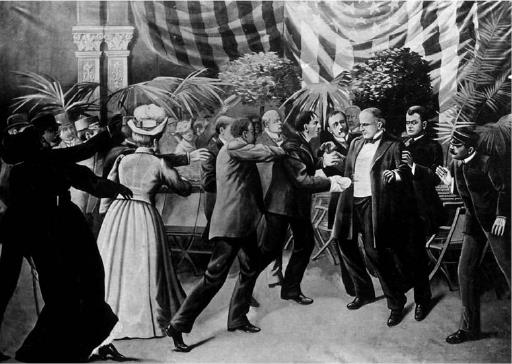Government and PoliticsThe American Presidency |
How many U.S. presidents have been assassinated? |
Four American presidents were assassinated in office: Abraham Lincoln, James Garfield, William McKinley, and John F. Kennedy.
Abraham Lincoln (1809–1865) was shot on the evening of April 14, 1865, as he sat in the presidential box of Ford’s Theatre in Washington, D.C., watching a performance of Our American Cousin. The man who fired the shot was actor John Wilkes Booth (1838–1865), who then jumped onto the stage, fell (breaking a leg), and limped away, calling out, “Sic semper tyrannis” (a Latin phrase meaning “Thus always to tyrants”). The president lived through the night, attended by family. He died just after 7:00 A.M. on April 15. He was succeeded in office by Vice President Andrew Johnson (1808–1875). On April 26 a search party found Booth in a Virginia barn, where he was fatally shot.
James Garfield (1831–1881) was en route to a class reunion at Williams College (Williamstown, Massachusetts), on July 2, 1881, when his assailant fired two shots at him in a Washington, D.C., train station. The shooter was Charles J. Guiteau (1841–1882), who held a grudge against the president. One of Guiteau’s bullets had only grazed the president; the other was fixed in his back, and doctors were unable to locate it. Today the president’s life might well have been spared, but the medical treatment of the late 1800s, which lacked both the X-ray machine and antiseptics, could not save him. He lived 80 days more, dying at a cottage on the New Jersey shore on September 19. He was succeeded in office by Vice President Chester Arthur (1830–1886). Guiteau’s trial lawyer would later claim that Garfield’s assassin was insane, but it was an unsuccessful plea for his life: In 1882 he was convicted and hung.
On September 6, 1901, President William McKinley (1843–1901) was attending a reception in Buffalo, New York, where the previous day he had delivered a speech. As he approached a man to shake his hand, the fellow fired two shots at McKinley. One bullet delivered only a minor flesh wound, but the other lodged in his stomach. Surgeons operated, but gangrene and infection set in, claiming the president’s life the morning of September 14. He was succeeded in office by Vice President Theodore Roosevelt (1858–1919). The shooter was identified as avowed anarchist Leon F. Czolgosz (1873–1901); he was tried, convicted, and put to death in 1901.
President John F. Kennedy (1917–1963), accompanied by his wife, Jacqueline Bouvier Kennedy (1929–1994), traveled in a motorcade through the streets of Dallas, Texas, on November 22, 1963. They were en route to the Dallas Trade Mart, where the president was scheduled to make a lunchtime speech. At 12:30 P.M., shots rang out; the president, who was riding in the back seat of a convertible, was hit in the neck and head. He was rushed to a nearby hospital, where he died at 1:00 P.M. The nation’s loss was immediately felt, as television and radio stations broadcast the message live that Kennedy had been shot and killed. He was succeeded by Vice President Lyndon Baines Johnson (1908–1973), who took the oath of office aboard an airplane just after 2:30 P.M.
Additionally there were assassination attempts on the lives of Presidents Andrew Jackson (April 14, 1835), Theodore Roosevelt (October 14, 1912), Franklin D. Roosevelt (February 15, 1933), Harry S. Truman (November 1, 1950), Gerald R. Ford (two attempts, both in September 1975), and Ronald Reagan (March 30, 1981). Theodore Roosevelt and Ronald Reagan recovered from their injuries; the others were not injured in the attempts.

